To Front
Page
INTIMATE
IMMENSITY
Program
Notes
Synopsis
Photos
Technical
Information
INTIMATE IMMENSITY
by Morton Subotnick
She
Joan La Barbara, vocalist
He
Thomas Buckner, vocalist
Cyber Angel
I Nyoman Wenten, Balinese dancer
The Hand
Nanik Wenten (on laser disc)
Lighting Design
Kyle Lemoi
Laser Disc Imagery
Woody Vasulka
Nature Images
Steina Vasulka
Digital Video Processing/
Aaron Davidson
Video Engineer
Audio Engineer/ Computer Op
Clay Chaplin
Production Assistant
Melissa Dubbin
Software Consultant
Mark Coniglio
Technical Consultant
John Potter
Intimate Immensity was developed
at the California Institute of the Arts in its
Center for Experiments in Art, Information
and Technology, an interdisciplinary
program for the development and application
of new, interactive technology in the arts.
The project was made possible by grants
from AT&T, the Rockefeller Foundation,
and the Peter and Eileen Norton Family
Foundation.
COMPOSERíS NOTE ON INTIMATE IMMENSITYSynopsisïPhotos
ï Technical
Information (Back to
Top of the Page)
Intimate Immensity has four performers: He, She, the Cyber-Angel
and the Hand
[a projected laser disc image]. The music is played by two
electronically controlled pianos and computer-generated, digitally
processed sounds. The lighting and the laser disc images are interactively
controlled through the computer and triggered by the performers.
The work is a meditation on our love affair with technology.
In our quest to be empowered, to be in control of our destinies and to
be free of the constraints of nature,
we are constantly creating new tools. The hand was the first
tool and thus takes on a prominent role in the work. We invented
magic and our gods to empower us as well.
The Cyber-Angel represents magical empowerment.
The text was inspired by ëThe Poetics of Spaceí
by Gaston Bachelard and ëHandís Endí by David Rothenberg.
There are also excerpts from Kafkaís ëParables and Paradoxesí
and references to Marshall McLuhan and Lewis Mumford.
In his book, ëThe Poetics of Spaceí, Gaston Bachelard
describes the space-time experience of daydreaming as an ëIntimate
Immensityí. In part 3, the characters He and She exist in
this daydream state which also represents the goal of the technological
journey toward complete freedom from the constraints of nature, even from
our own bodies.
The Cyber-Angel, performed by a traditional Balinese dancer
(I Nyoman Wenten), was conceived as a god-like figure who mysteriously
controls the environment of two pianos [Disklaviers], video imagery, voices
and lights. In the opening sequence, he activates a giant projected
hand which gradually learns to talk and play music. Through commentary
and parables the Angel and the Hand tell about our immense journey from
the earliest use of tools (our hands) to ìa world without time ...
a world without spaceî.
He and She sit at their work tables. He is reading; She
is writing. Both move in and out of a daydream state [Intimate Immensity]
from which they eventually do not return. With arm gestures they
trigger light, video and sound events. At other times, their voices control
video transformations. They are seen and heard as if in different
locations (futuristic telephonic ësitesí), each performing
a meditation on His/Her sense of Intimate Immensity, a duet of parallel
performances. We hear what they sing and speak mixed with what the
ìthinkî through amplified computer versions of their voices.
They are not aware of each other though they interact with the Angel whom
they dreamed into being. Each has differing views of the new space.
He reads and expresses ideas about technology which are accepting and intuitive,
while She writes and expresses ideas about technology which are more
cautious and thoughtful. Since the new space has no apparent boundaries,
the characters gradually merge with one another as they lose their
bodies and move into the Intimate Immensity. As the work draws to
a close, images of their faces merge with those of corridors infinitely
receding.
The images are on 5 laser discs. Through the computer
software, any frame (image) on any of the laser discs can be accessed at
any time. Once the frame is accessed, the Laser disc player can be
told to hold the frame (still image) or play forward or back at any speed.
This technique allows me to choreograph (animate) the images in real time.
In addition, the software application, ìImag/ineî. is used
to incorporate real-time video processing.
In developing the concept for the laser disc images with Woody
Vasulka, I was looking for a progression of images that supported the general
narrative and a sense of imagery that amplifies and extends certain concepts
suggested in the text. The latter is most obviously seen in the transformed
images of nature and, in Part 2, the progression of increasingly more abstract
images of He and She.
The music plays two roles. The music of the performers,
which includes the live piano music, supports the ënarrativeí
development on the stage. There is also music, played by the computer,
which is a collage of modifications of pre-recordings of the piano [including
inside piano sounds], the two vocalists and the Balinese dancer.
This music acts like an interior dialogue. It is the world of the
inner self, or perhaps, the Intimate Immensity. Sometimes the
two musics act alone and sometimes are juxtaposed.
The performers interact with the computer by means oftheir voices
and eight infrared sensors strategically placed on the stage. All
the signals are sent to the computers where two software programs, Interactorì
and Image/ine reside. The two software programs were programmed to convert
these signals to control lights, five laser discs, two Disklaviers, internal
sounds in the computer, two CD ROMs, video processing and audio file verbal
prompting for the performers.
I refer to Intimate Immensity as ëëa media
poemî. It has always been difficult to decide whether much
of the staged work of the last half of this century is ìoperaî,
or ìtheater pieceî, or ìperformance artî.
I am adding another category to the list, by calling Intimate Immensity
a media poem. In creating the work I felt as if I have been constructing
a giant four dimensional poem, just as poems have sound, musical phrases,
evoke imagery and idea. In this, and most of my work, all the media
function together, each conveying an aspect of the workís meaningfulness,
similar to the way the gesture of oneís body participates in the
way we communicate and the way memory alters the way we perceive the meaning.
In traditional theater the set, lights, images and music tend to create
the context for the charactersí action, whereas in my work the action
on the stage (especially of He and She) functions to set a
context for the various media. The Cyber-Angel, on the other hand,
is moving freely. He is the embodiment of our godlike creations which
we have empowered with the freedom we can only dream to attain. Our
gods like our technologies, once created, can alter us forever.
---Morton Subotnick
Synopsis Program
Notes sïPhotos
ï Technical
Information (Back
to Top of the Page)
Intimate Immensity is in three parts:
Part 1:
ìin the beginningÖî Music is heard in darkness.
An amorphous projected object gradually evolves into a fist. The Cyber-Angel
is then revealed and, in silence, teaches the projected fist to open into
a hand. Then, through his own hand gestures, the Angel teaches the Hand
to speak. And, by performing the ìairî in front of him, the
Angel remotely plays one piano while the Hand tries to imitate him with
the other piano.
Part 2:
ìThe Tower of BabelÖî is an interaction between
the Angel and He and She. The Angel, dancing, singing and speaking, leads
He and She in a ritualistic music-dance based on the Monkey Chant. Alternating
between the chorus of rhythmic punctuation and singing, and a refrain in
which the Angel relates a creation myth in Kawi [an ancient Javanese language],
He and She vocalize and, through arm gestures, punctuate with percussive
sounds and images, while their voices are heard speaking fragments of ideas
from Marshall McLuhan and Lewis Mumford. This section culminates as the
Hand emerges over the two pianos and joins She and He in a virtuosic performance.
Part 2 ends, ìThe Death of Godî, a voice tells Kafkaís
parable of the Emperor who sent a messenger to deliver an important message
to us as the Angel dances.
(Translation of the Creation Myth:
Dadia, ta pinten kunanag Iawas Ikang kala
Who knows when time began
Kadi gelap sumarasah anusup ing randu parajamanala
When earth, wind, and fire trembled and quaked into being,
apah, teja, banyu, akasa Iawan pretiwi.
Followed by the sacred tree of life, by people and all creation.
Mijil a ri gatinira Sang Hyang Sunlyantrara amunggel punanag
cerita
The Divine Void comes forth, measuring out the universe.)
Part 3:
a) ìIntimate Immensityî is a series of meditations
by He and She on Intimate Immensity. From time to time, the Angel is seen
on his journey where he occasionally stops to create a new world.
b) ìA world without time. A world without spaceÖî
He and She are approaching the end of their journey toward complete freedom
from the limits of nature and their bodies. They sing and speak of a growing
immensity within themselves. Their own transformed images appear behind
them.
The daydream state takes over as their bodies gradually disappear.
They sing, the pianos play an accompaniment, and the images gradually grow
more abstract as each of their images merges with the otherís.
Their bodies are gone. They sing and speak of the sensation of a
bodiless mind in a world without time or space. Their images merge with
a series of images that are receding into infinity.
* * * * * * * * * * * * *

The hand as seen on the center screen early in the work.
It has been controlled by the Cyber Angel [Balinese Dancer].
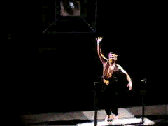
The Angel controlling sound and the image behind him
by activating the infrared beam.
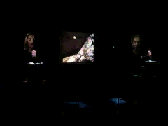
This image shows the two vocalists with images
behind each as well as the center screen.
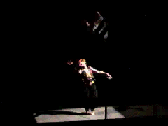
This is another example of the Angel
ontrolling the rear image.

Here the monitor has the hand in it
while the Disclaviers play.

In this picture, the Angel is controlling
both disclaviers and the image behind him.
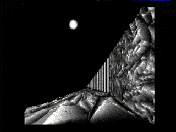
This landscape is scene with various superimpositions
throughout the middle of the work.
The Angel controls its modulation with his voice.

Here we see the male singer and the angel
interacting with the images and the piano.
The singer has just caused the left wall of the center image to explode
while the Angel is playing the piano.
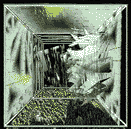
Here is a close up of the wall exploding..
in this case the female singer has caused her side to explode.
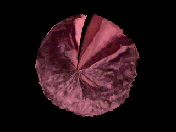
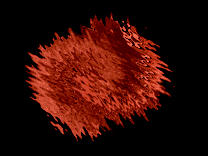
On the left we see a ball of fire. On the right is an example
of vocal modulation on the ball.
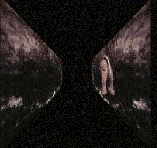
At the end of the work, the dancer and the two singers have vanished
and their images become embedded in receding walls.
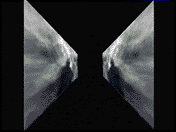
It ends as their shadows move out into infinity.
Only their voices are heard, shifting through the auditorium space.
Technical Information Program
Notesï SynopsisïPhotos
ï(Back to Top of the
Page)
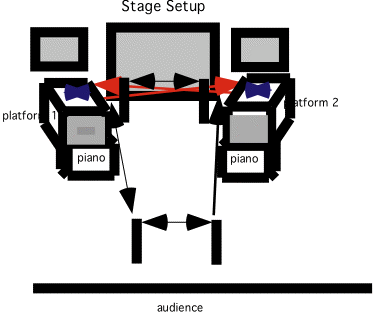
The male vocalist is on platform 1 and the female vocalist is on platform
2. In fron of each are mounted a mic and an infra red beam controller
[in blue] on the diagram. From the sides of the platform [at waist heght
to the vocalists/and head height to the dancer]are two more infra red beams
[denoted in orange on the diagram]. Behind each vocalist is a rear
projection screen with an LCD projector behind each screen. Between
the platforms and to the rear of the stage is the large center screen which
is serviced by a larger projector, either front or rear depending on the
stage. In front of each platform is a disclavier and over each piano
is a video monitor.
The dancer moves in the front area of the stage as well as the space
between the two platforms. He wears a wireless mic and activates
6 infra red beams.
Four of the beams are waist high and located: 1 in front, 1 in rear,
1 on each side. The reamining two are overhead and shared with the vocalists.
All three performers wear wireless head sets to receive cues.
The Techno Ingredients
There are two desktop computers [Mac]. One [main computer] hosts
all the audio files and the main controlling application and file [Interactor].
The other [image computer] hosts the software application,'Imagine' which
sends stored images and controls the manipulation of video images.
We used two laptops [mac] which contained the audio files for the cueing
of the three performers. Each of these also contained an Interactor file.
In addition to the computers there are three video projectors, 5 laser
disc players, a midi light board and a midi controlled video switcher.
How It Works
Immensity runs in a combination of modes. Some of it is driven
by the performers, some by the computer operator, and some aspects are
timed.
Input To The Computers.
Each Infra red beam is associated with a particular note on midi message.
When a beam is broken it sends a signal to the main computer which, through
Interactor, is given instructions as to what event should occur.
Their voices are sent to the mixer to be heard and also sent to the image
compouter to control [through Imagine] video imagery.
Output From the Computers.
The main computer [through Interactor] sends messages to:
1ïAny combination of the 5 laserdisc players. These messages
contain controls for START, STOP, SPEED, DIRECTION [FORWARD OR BACK], STILL
FRAME, AT WHICH FRAME TO START, and AT WHICH FRAME TO STOP.
2ïThe video switcher. This tells which laserdisc player will be
routed to which combination of projectors and/or monitors.
3ïSound files are played on cue from the hard drive and
the internal cd-rom of the main computer. Here the loudness is controlled
as well as the start and stop of each sound.
4ïThe main compouter tells the image computer which set of images
and manipulations [presets] to use.
5ïInformation is sent to the two laptops to send the proper cue
to the performers.
6ïProgram changes are sent to the midi light board to change the
lights. The midi light board is preprogrammed.
7-In addition to audio files, the computer controlls the two
disclaviers through midi signals.
The work is in 22 'scenes' most of which advance automatically, but,
a computer operator is always there to advance the computer if something
goes wrong.

(Back to Top of the Page)
Back
to Front Page












